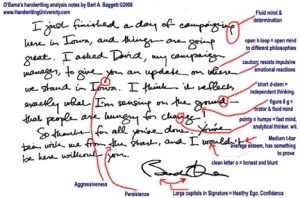What does your hand writing say about you?
Graphology (graphoanalysis) is the study of handwriting, especially when employed as a means of analyzing character and personality traits. Graphologists use handwriting analysis to define a person’s character from more than 5,000 personality traits. The size of your letters, the angle, the scribbles you make, spacing between words, shapes of letters and more can all signify different characteristics. They can even be used for detecting lies and revealing possible health ailments. Real handwriting experts are known as forensic document examiners, not as graphologists. Forensic (or questioned) document examiners consider loops, dotted "i's" and crossed "t's," letter spacing, slants, heights, ending strokes, etc. They examine handwriting to detect authenticity or forgery. A person's handwriting is as unique as their personality. Plus, it makes for an interesting conversation when discussing connecting the two. Graphology is a fun exercise, especially if you're testing someone you know, but it has very limited accuracy. If you're interested in a more scientific basis, learn how forensic investigators compare the handwriting of suspects and ransom notes. Handwriting Analysis 101:- People who write letters close together are intrusive and crowd others
- Illegible signatures mean a person is private and difficult to understand
- Words or sentences that vary to the rest of the text suggest it is a lie
- Schizophrenia and high blood pressure can also be identified from writing
- If letters reach down into the lower zone that represents the area of materialism
- Ascending base lines show energy, enthusiasm and initiative
- Small writing shows a good ability to concentrate but can also suggest an introverted person
- Slant changes and a sudden upsurge in height shows impulsiveness
- Men’s signatures often settle down by the time they are 18 as they mature
- Curved, looped, rhythmic writing shows altruism, friendliness and a sense of balance
- If pressure of the writing increases towards the end of words it symbolizes increased commitment to a project as time goes on
- If you have a right slant, you are warm and open
- Over a third of us have messy handwriting, with almost one in ten saying it’s ineligible

How Graphology is Supposed to Work
Graphologists analyze handwriting features such as:- Slant: Right slant may indicate expressiveness, left slant may suggest introversion.
- Size: Large handwriting might suggest confidence, small handwriting could indicate introspection.
- Pressure: Heavy pressure might mean strong emotions, while light pressure could suggest sensitivity.
- Spacing: Wide spacing may reflect independence, while narrow spacing might show sociability.
- Letter Shapes: Rounded letters might indicate creativity, sharp letters could suggest aggression or intelligence.
Scientific Validity
- Lack of Empirical Support: Studies have found little to no correlation between handwriting and personality traits as measured by established psychological tests.
- Subjectivity: Interpretations vary among graphologists, making results inconsistent.
- No Theoretical Basis: Unlike psychology, which relies on tested theories, graphology lacks a clear scientific foundation.
- Forensic Analysis: Handwriting analysis can help in signature verification and document authentication.
- Therapeutic Insights: Some therapists use expressive writing to understand emotional states, though this is not the same as personality assessment.
- Historical and Cultural Studies: Examining handwriting can provide insight into historical figures’ emotions and mental states.
Bottom Line
Graphology may be fun and intriguing, but it is not a reliable tool for understanding personality. If you're serious about personality assessment, methods like the Big Five Personality Traits, Myers-Briggs Type Indicator (MBTI), or psychological interviews are far more accurate. What is the psychology behind handwriting? The psychology behind handwriting, often referred to as graphopsychology, is based on the idea that handwriting is a motor behavior influenced by cognitive, emotional, and neurological factors. While graphology (personality assessment from handwriting) is widely debated, psychology does recognize that handwriting can reflect certain mental and physiological states.Psychological Aspects of Handwriting
- Motor and Cognitive Control
- Handwriting is a complex motor skill controlled by the brain. It involves fine motor coordination, memory, and learned patterns.
- The way a person writes can be affected by their mood, stress levels, fatigue, or neurological conditions.
- Emotional Influence
- People’s handwriting may change based on their emotional state.
- Under stress or anxiety, handwriting may become more erratic, uneven, or pressed harder onto the paper.
- When calm, handwriting tends to be more fluid and consistent.
- Neurological Impact
- Handwriting can reflect neurological conditions such as Parkinson’s disease (micrographia—abnormally small writing) or dysgraphia (difficulty writing).
- Brain injuries or mental health disorders may also lead to noticeable handwriting changes.
- Personality Expression (Though Debated)
- Some psychologists believe consistent aspects of handwriting (e.g., slant, pressure, spacing) could reflect certain tendencies—for example, large writing might indicate extroversion, while small, controlled writing might suggest introversion.
- However, scientific studies have not found strong, repeatable correlations between handwriting and personality traits.
- Cultural and Learned Influences
- Education, handwriting training, and cultural writing norms shape how people write.
- Over time, individual styles develop, but they are influenced by early writing habits rather than deep personality traits.
Handwriting in Psychological and Forensic Analysis
- Forensic handwriting analysis (not to be confused with graphology) is used to verify signatures and detect forgery.
- Expressive writing therapy uses handwriting as a tool to process emotions and trauma.
- Handwriting analysis in mental health is sometimes used to assess cognitive decline or emotional distress.
